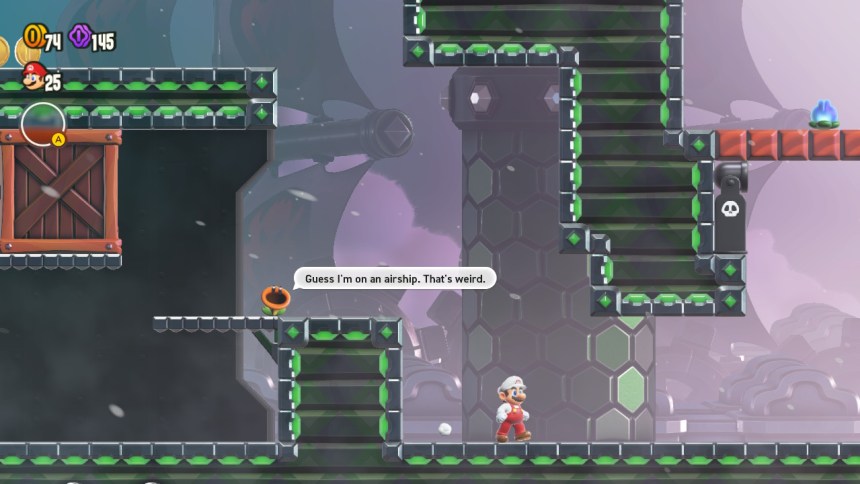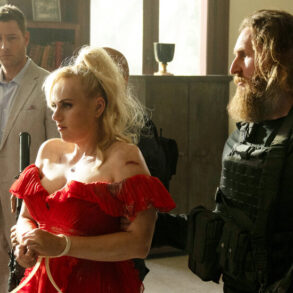Wonder is the sense of amazement or admiration that comes from something beautiful, remarkable, or unfamiliar. When we use the word, we often attribute it to the celestial sights, or to a child’s first experiences, however benign. It’s a word thrown around too easily with the adjective “wonderful”, and the almost superfluous way that we attach it to something less than remarkable, i.e. “You were wonderful mowing the lawn.” The true sense of the word – something at almost scares us in terms of disbelief – is so rare in the true usage that we might scoff when added to a video game, especially one as long in the tooth as Super Mario Brothers. But I can attest, with absolute sincerity, the feeling that comes from Super Mario Bros. Wonder.
There is a story – of course there is – but the song remains the same once you boil off the Flower Kingdom, the Wonder Seeds, and all the other accouterments that make children and Mario lore enthusiasts excited. Bowser is being a jerk, and Mario and crew needs to stop him. It’s little more than a garnish on the side of a bountiful meal, something to visually please the person before they gorge themselves on sumptuous and almost decadent food. You might also accidentally eat the garnish once in a while, and that’s fine too: if you’re all in on yet another place where Bowser flexes and uses only one child instead of the eight he had once upon a time, you enjoy that story. Meanwhile, I’ll be over here, losing my mind over the level design.
Divided into six worlds with a hub world to connect them and a final boss world, Super Mario Bros. Wonder is not shortchanging players. In order to advance, each stage will have between one to three Wonder Seeds: a magical acorn that is needed to purchase advancement to further areas. Naturally, you don’t need all of them; I finished the third world with several stages completely untouched because I was in a hurry. But the completionist in you will drag you back in to make sure you find all the seeds, especially in this case. Not only are there a variety of ways to entice your completionist mind – three purple coins to find, a marker if you hit the top of the flagpole at the end – there’s also the Wonder Flower, which might be the most creative thing Nintendo’s added to a Mario game in years.
The Wonder Flower activates a sort of challenge stage where everything goes haywire and you need to accomplish it, sometimes in a limited amount of time, in order to get a Wonder Seed. These stages can go from topsy turvy (water on the ceiling, changing to an overhead, isometric perspective) to absolutely beyond comprehension (musicals break out, you turn into a Goomba). Every single Wonder Flower is a giddy discovery to find out what happens when developers throw the kitchen sink at concept brainstorming and say “Whatever it is, we’ll figure out how to do it!” There wasn’t a single one where I was bored or disappointed – nothing was ever totally expected unless I had already done it.
In terms of control, Super Mario Bros. Wonder is a bit floaty, and I think that’s to add to the effervescent nature of the game. Mario and his cohorts aren’t drum tight in movement, and it can take a bit of getting used to in order to nail the more difficult secrets and out-of-reach items. It’s not disjointed, you can very easily get the game in hand, but it’s perhaps not to the same level of precision that we saw in, for example, Super Mario Odyssey that demanded a lot of pinpoint landings, particularly in the Luigi DLC. That’s not to say there isn’t plenty of challenge in Wonder, but it hits differently, perhaps because of the target audience.
The challenge further derives from the inclusion of classic enemies with the intermingling of new. Super Mario Bros. Wonder makes sure that mainstays like Goombas and Koopa Troopas get their turn to shine, but the new baddies that bring new mechanics to the game are showcased in due diligence. While some are just annoying on purpose (I truly dislike the diving birds in the water level), the others create microcosms of gameplay that stand on their own in terms of adding to the level. The enemies that hop along with you when you jump, the birds that create platforms with their beaks, even the new snail baddies that feel like Troopa derivatives are still great on their own because they’re different. Changing a small aspect of how to interact with these monsters produces a brand new approach that’s exciting and challenging for new and old players alike.
Wonder is also another stab at Nintendo getting the multiplayer aspect right, and I think it’s…better. It’s not perfect yet, but I can appreciate what is happening. The inclusion of semi-invincible Yoshi or Nabbit characters is helpful, but it’s only halfway there in terms of execution. They can’t get hurt from enemies, but they can still die from touching lava or falling off the screen.
If you die and you become a ghost, you have only five seconds to touch the living player(s) to respawn without a penalty, a challenging ask when children are playing. As I’m rather old hat at Mario platforming, I sometimes found myself just screaming along at near sonic levels while the spirits of my departed daughters chased me down against the clock. Also, no one wants to be Yoshi or Nabbit because the power-ups don’t work on them (except the Star) and not getting a chance to transform means losing half the fun of Super Mario Bros. Wonder.
Elephant Mario is in my top three power-ups. He’s adorable to behold, incredibly powerful, SO well animated, and has versatility with both having his trunk to smash bricks and also to suck up and spray water (much to the Flower Kingdom’s delight). The drill hat is a tricky one to master, as it worked best in Super Mario Galaxy, and translated mostly well to 2D. It’s not perfect, especially with Joy-Con controls (I kept leaving the dirt/drilling down when I didn’t intend to) but it’s good. The bubble flower was a disappointing pain in the ass that sometimes did what it was supposed to (seek and capture enemies, create one time platforms) and sometimes just annoyed me. If I could help it, I never wanted to use the flower. Always elephant.
The badges are also a mixed bag of silliness and support that players should absolutely explore in order to see what makes their Super Mario Bros. Wonder experience best. With so many jump modifiers, it was a veritable buffet of how to approach each stage: floating jump, spinning jump, Piranha Plant grappling hook, and several others that all changed gameplay entirely. The assist badges are great for players who maybe are less confident about their approach (coin magnet, one-time lava save) but none of them are so wildly unbalanced that they dominate choices from level to level. It’s the perfect situation of alteration of core gameplay without overhauling something so much that it breaks.
I turned into a whole ass platform. We’ve gone Meta Mario.
The music, as always, is the icing on top of the cake that is Super Mario Bros. Wonder. You would think that the well trodden realm of Mario based music would become almost cookie cutter at this point, but it still continues to evoke the feelings of whimsy and delight while peppering in foreboding and menace at just the right moments. From the open fields with the gentle notes of hope to the sudden airships that demand rigorous determination to pass safely, the score drives players forward and helps to further accent the atmosphere of what’s transpiring. It would be an understatement to say that the music makes the game complete: without the gentle mind of Koji Kondo to continue to craft Mario’s aural adventure, there would be an entire facet of joy missing from the game.
When I look at Super Mario Bros. Wonder, it puts me into the headspace of Super Mario World. It cannot be overstated how amazing Super Mario World was. As a flagship title for the newly created Super SNES/Super Famicom, Nintendo knew they needed to grab people’s attention immediately, and Super Mario World did that in a big way. A brilliant stroke of design, this title took an already excellent series and elevated it in all the important ways. You had new, bigger worlds, a more complex and intricate map system compared to Super Mario Bros. 3, and a host of new concepts, including the Cape Feather and Yoshi, who spawned his own successful series of games.
But, at the core, the same familiar gameplay that NES users knew and loved existed, and was tightened and strengthened. As beautiful and gnarly as things were, you knew the key concepts of running, jumping, stomping Goombas and hitting blocks. That, more than anything else, is the secret sauce that makes Super Mario Bros. Wonder the incredible feat of design and enjoyment that has now dominated my household and my free time. I think the constant homages to games of the past – from the palaces at the stage conclusion to the Flower houses that evoke the Toad houses of Super Mario Bros. 3 – show that the developers aren’t aping from their previous catalog, but acknowledging it and reminding the audience as well as themselves how far we’ve come in the genre.
It’s easy to dismiss it in the current realm of next generation titles. “Oh, a Mario platformer. I bet you defeat Bowser, huh?” But it’s not about what’s new and shiny: it’s about what works. It’s about that connection to the fun and the magic that keeps Mario timeless.
Super Mario Bros. Wonder is easily the best new 2D Mario in a very long time, and it’s really fighting for my number one or two spot. Recency bias has it going head to head with older titles, but that’s the great part: you don’t have to decide. Each game brings something to the table, and Wonder’s new everything – enemies, power ups, level design – keeps it brimming with potential all the way to the very end. Stubborn players will have hours upon hours of completion goals to achieve, and casual runners will be defying the odds to see who can crush Bowser in record time. In short, Nintendo has achieved their goal: a Mario title that truly crafts awe and delight across the board.
|
Graphics: 9.5 Colorful, dynamic and positively bursting with creativity, there’s always something new and compelling to behold around every corner. |
Gameplay: 9.0 Single player is everything you’d want and expect from a Mario game. Multiplayer tries hard but is a bit wonky for young or inexperienced players. |
|
Full of ambience, orchestral grace, and a full exploration of the Nintendo soundscape, this is the most ambitious soundtrack since Mario Odyssey. |
Fun Factor: 10 If you’re a Mario fan, there’s simply no stopping this juggernaut of a game. Fanciful, furious and fantastic, it’s just plain fun. |
|
Final Verdict: 9.5 |
|
Super Mario Bros. Wonder is available now on Nintendo Switch.
Reviewed on Nintendo Switch.
Check these out!
This post was originally published on this site be sure to check out more of their content.









